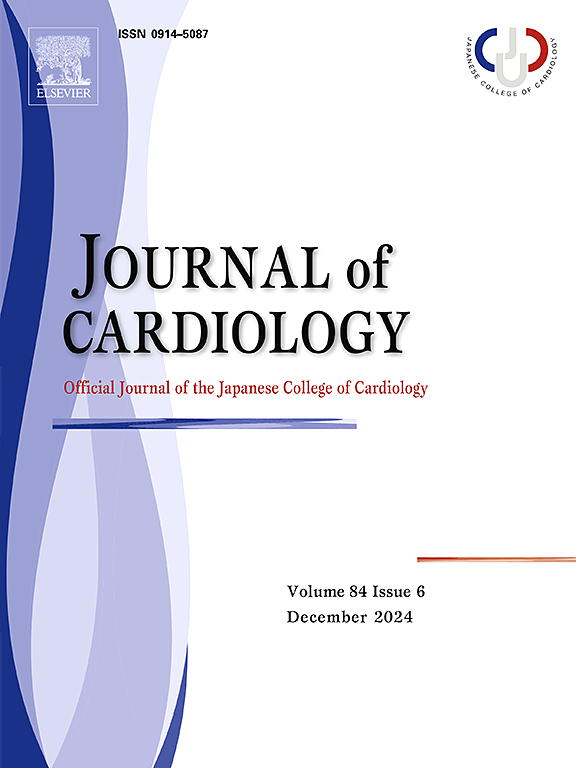Molecular imaging of cardiovascular disease: Current status and future perspective
IF 2.5
3区 医学
Q2 CARDIAC & CARDIOVASCULAR SYSTEMS
引用次数: 0
Abstract
Advancements in knowledge of cardiovascular disease, pharmacology, and chemistry have led to the development of newer radiopharmaceuticals and targets for new and more suitable molecules. Molecular imaging encompasses multiple imaging techniques for identifying the characteristics of key components involved in disease. Despite its limitations in spatial resolution, the affinity for key molecules compensates for disadvantages in diagnosing diseases and elucidating their pathophysiology. This review introduce established molecular tracers involved in clinical practice and emerging tracers already applied in clinical studies, classifying the key component in A: artery, specifically those vulnerable plaque (A-I) inflammatory cells [18F-FDG]; A-II) lipid/fatty acid; A-III) hypoxia; A-IV) angiogenesis; A-V) protease [18F/68Ga-FAPI]; A-VI) thrombus/hemorrhage; A-VII) apoptosis and A-VIII) microcalcification [18F-NaF]) and B: myocardium, including myocardial ischemia, infarction and myocardiopathy (B-I) myocardial ischemia; B-II) myocardial infarction (myocardial damage and fibrosis); B-III) myocarditis and endocarditis; B-IV) sarcoidosis; B-V) amyloidosis; B-VI) metabolism; B-VII) innervation imaging). In addition to cardiovascular-specific tracers tested in animal models, many radiotracers may have been developed in other areas, such as oncology imaging or neuroimaging. While this review does not cover all available tracers, some of them hold potential for future use assessing cardiovascular disease. Advances in molecular biology, pharmaceuticals, and imaging sciences will facilitate the identification of precise disease mechanisms, enabling precise diagnoses, better assessment of disease status, and enhanced therapeutic evaluation in this multi-modality era.
心血管疾病的分子成像:现状和未来展望。
心血管疾病、药理学和化学知识的进步导致了更新的放射性药物和新的、更合适的分子靶标的发展。分子成像包括多种成像技术,用于识别与疾病有关的关键成分的特征。尽管在空间分辨率上有局限性,但对关键分子的亲和力弥补了在诊断疾病和阐明其病理生理方面的缺点。本文综述了临床实践中已建立的分子示踪剂和已应用于临床研究的新兴示踪剂,对A:动脉中的关键成分,特别是易损斑块(A- i)炎症细胞进行了分类[18F-FDG];A-II)脂质/脂肪酸;A-III)缺氧;iv)血管生成;A-V)蛋白酶[18F/68Ga-FAPI];一个vi)血栓或出血;A-VII)细胞凋亡和A-VIII)微钙化[18F-NaF])和B:心肌,包括心肌缺血、梗死和心肌病(BI)心肌缺血;B-II)心肌梗死(心肌损伤及纤维化);B-III)心肌炎和心内膜炎;B-IV)结节病;BV)淀粉样变;B-VI)代谢;B-VII)神经支配成像)。除了在动物模型中测试的心血管特异性示踪剂外,许多放射性示踪剂可能已经在其他领域开发出来,例如肿瘤成像或神经成像。虽然本综述并未涵盖所有可用的示踪剂,但其中一些示踪剂在未来评估心血管疾病方面具有潜力。在这个多模式的时代,分子生物学、制药和成像科学的进步将有助于确定精确的疾病机制,实现精确的诊断,更好地评估疾病状态,并加强治疗评估。
本文章由计算机程序翻译,如有差异,请以英文原文为准。
求助全文
约1分钟内获得全文
求助全文
来源期刊

Journal of cardiology
CARDIAC & CARDIOVASCULAR SYSTEMS-
CiteScore
4.90
自引率
8.00%
发文量
202
审稿时长
29 days
期刊介绍:
The official journal of the Japanese College of Cardiology is an international, English language, peer-reviewed journal publishing the latest findings in cardiovascular medicine. Journal of Cardiology (JC) aims to publish the highest-quality material covering original basic and clinical research on all aspects of cardiovascular disease. Topics covered include ischemic heart disease, cardiomyopathy, valvular heart disease, vascular disease, hypertension, arrhythmia, congenital heart disease, pharmacological and non-pharmacological treatment, new diagnostic techniques, and cardiovascular imaging. JC also publishes a selection of review articles, clinical trials, short communications, and important messages and letters to the editor.
 求助内容:
求助内容: 应助结果提醒方式:
应助结果提醒方式:


